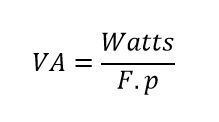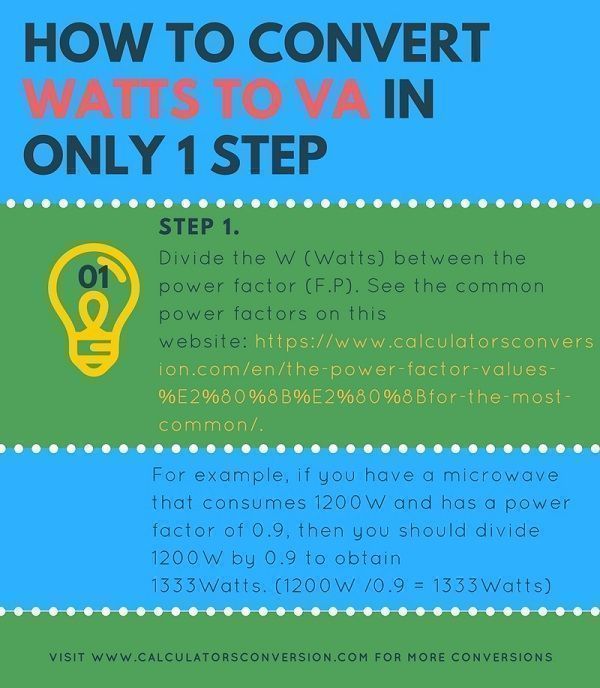With this tool you can convert from Watts to VA , we also explain the formula with its variables and to clarify the conversion some examples are presented.
At the end there is a table with the main equivalences . A piece of data that is somewhat difficult to obtain is the power factor .
Watt to VA calculation formula:
How to convert Watts to VA in only 1 step.
Step 1:
Divide the W (Watts) between the power factor (F.P). See the common power factors on this website: http://calculatorsconversion.com/en/the-power-factor-values-%E2%80%8B%E2%80%8Bfor-the-most-common/.
For example, if you have a microwave that consumes 1200W and has a power factor of 0.9, then you should divide 1200W by 0.9 to obtain 1333Watts. (1200W /0.9 = 1333Watts)
Definition F.P, S (VA) and P (Watts):
Watts: is Working Power (also called Actual Power or Active Power or Real Power). It is the power that actually powers the equipment and performs useful work.
The real power in watts is the power that performs work or generates heat. Power in watts is the rate at which energy is consumed (or generated). One watt is one joule (energy) per second (1 W = 1 J/s).
Resistive devices or loads such as heaters, incandescent lamps are rated in W.
VA: A kilovolt-ampere, commonly referred to as a VA, is commonly used as a unit of power in obtaining the electrical capacity of circuit breakers, uninterrupted power supplies and wirings.
VA is larger than W because loads are inductive such as motors, discharge lighting, reactors and more current is required to keep the magnetic field energized than is -turned into heat (W).
Inductive devices or loads such,. as tansformers and motors having power factor less than 1.0 are generally rated in VA.
F.p: Power factor is the ratio of working power to apparent power. It measures how effectively electrical power is being used. A high power factor signals efficient utilization of electrical power, while a low power factor indicates poor utilization of electrical power.
Power Factor is the cosine of the phase angle between current and voltage.
Power Factor is the ratio of true power to apparent power.
Typical Un-improved Power Factor by Industry:
| Industry | Power Factor |
| Auto Parts | 0.75-0.80 |
| Brewery | 0.75-0.80 |
| Cement | 0.80-0.85 |
| Chemical | 0.65-0.75 |
| Coal Mine | 0.65-0.80 |
| Clothing | 0.35-0.60 |
| Electroplating | 0.65-0.70 |
| Foundry | 0.75-0.80 |
| Forging | 0.70-0.80 |
| Hospital | 0.75-0.80 |
| Machine Manufacturing | 0.60-0.65 |
| Metalworking | 0.65-0.70 |
| Office Building | 0.80-0.90 |
| Oil field Pumping | 0.40-0.60 |
| Paint Manufacturing | 0.65-0.70 |
| Plastic | 0.75-0.80 |
| Stamping | 0.60-0.70 |
| Steel Works | 0.65-0.80 |
| Tool, dies, jigs industry | 0.65-0.75 |
Typical power factor of common household electronics:
| Electronics device | Power Factor |
| Magnavox Projection TV – standby | 0,37 |
| Samsung 70″ 3D Bluray | 0,48 |
| Digital Picture Frame | 0,52 |
| ViewSonic Monitor | 0,5 |
| Dell Monitor | 0,55 |
| Magnavox Projection TV | 0,58 |
| Digital Picture Frame | 0,6 |
| Digital Picture Frame | 0,62 |
| Digital Picture Frame | 0,65 |
| Philips 52″ Projection TV | 0,65 |
| Wii | 0,7 |
| Digital Picture Frame | 0,73 |
| Xbox Kinect | 0,75 |
| Xbox 360 | 0,78 |
| Microwave | 0,9 |
| Sharp Aquos 3D TV | 0,95 |
| PS3 Move | 0,98 |
| Playstation 3 | 0,99 |
| Element 41″ Plasma TV | 0,99 |
| Current large, flat-screen television | 0,96 |
| Windows-mount air conditioner | 0,9 |
| Legacy CRT-Based color television | 0,7 |
| Legacy flat panel computer monitor | 0,64 |
| While-LED lighting fixture | 0,61 |
| Legacy laptop power adapter | 0,55 |
| Laser Printer | 0,5 |
| Incandescent lamps | 1 |
| Fluorescent lamps (uncompensated) | 0,5 |
| Fluorescent lamps (compensated) | 0,93 |
| Discharge lamps | 0,4-0,6 |
Typical Motor Power Factors:
| Power | Speed | Power Factor | ||
| (hp) | (rpm) | 1/2 load | 3/4 load | full load |
| 0 – 5 | 1800 | 0.72 | 0.82 | 0.84 |
| 5 – 20 | 1800 | 0.74 | 0.84 | 0.86 |
| 20 – 100 | 1800 | 0.79 | 0.86 | 0.89 |
| 100 – 300 | 1800 | 0.81 | 0.88 | 0.91 |
Reference // Power Factor in Electrical Energy Management-A. Bhatia, B.E.-2012
Power Factor Requirements for Electronic Loads in California- Brian Fortenbery,2014
http://www.engineeringtoolbox.com
Watts to VA table chart for conversion, equivalence, transformation:
| Watts | F.P (Factor de potencia) | VA |
| 1 | 0,75 | 1,33 |
| 2 | 0,75 | 2,67 |
| 3 | 0,75 | 4,00 |
| 4 | 0,75 | 5,33 |
| 5 | 0,75 | 6,67 |
| 6 | 0,75 | 8,00 |
| 7 | 0,75 | 9,33 |
| 8 | 0,75 | 10,67 |
| 9 | 0,75 | 12,00 |
| 10 | 0,8 | 12,50 |
| 20 | 0,8 | 25,00 |
| 30 | 0,8 | 37,50 |
| 40 | 0,8 | 50,00 |
| 50 | 0,8 | 62,50 |
| 60 | 0,8 | 75,00 |
| 70 | 0,8 | 87,50 |
| 80 | 0,8 | 100,00 |
| 90 | 0,8 | 112,50 |
| 100 | 0,85 | 117,65 |
| 200 | 0,85 | 235,29 |
| 300 | 0,85 | 352,94 |
| 400 | 0,85 | 470,59 |
| 500 | 0,85 | 588,24 |
| 600 | 0,85 | 705,88 |
| 700 | 0,85 | 823,53 |
| 800 | 0,85 | 941,18 |
| 900 | 0,85 | 1058,82 |
| 1000 | 0,9 | 1111,11 |
| 2000 | 0,9 | 2222,22 |
| 3000 | 0,9 | 3333,33 |
| 4000 | 0,9 | 4444,44 |
| 5000 | 0,9 | 5555,56 |
| 6000 | 0,9 | 6666,67 |
| 7000 | 0,9 | 7777,78 |
| 8000 | 0,9 | 8888,89 |
| 9000 | 0,9 | 10000,00 |
| 10000 | 0,95 | 10526,32 |
| 20000 | 0,95 | 21052,63 |
| 30000 | 0,95 | 31578,95 |
| 40000 | 0,95 | 42105,26 |
| 50000 | 0,95 | 52631,58 |
| 60000 | 0,95 | 63157,89 |
| 70000 | 0,95 | 73684,21 |
| 80000 | 0,95 | 84210,53 |
| 90000 | 0,95 | 94736,84 |
| 100000 | 1 | 100000,00 |
| 200000 | 1 | 200000,00 |
| 300000 | 1 | 300000,00 |
| 400000 | 1 | 400000,00 |
| 500000 | 1 | 500000,00 |
| 600000 | 1 | 600000,00 |
| 700000 | 1 | 700000,00 |
| 800000 | 1 | 800000,00 |
| 900000 | 1 | 900000,00 |
| 1000000 | 1 | 1000000,00 |

